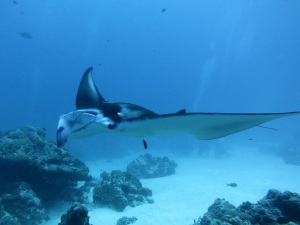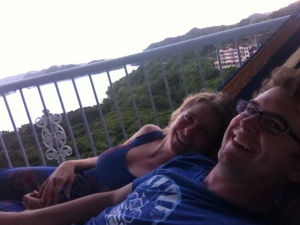Our year in Palau is rapidly approaching its end: four weeks and counting until Brian wraps up work and we head off island indefinitely. With that deadline looming, we are checking things off of our Island Bucket List. And, consequently, slacking on the blog! A few more posts, though, before we go…
This one is Part 2 in a series I started earlier this year on the magical mystery tour that is Palau’s underwater world. Without further ado, our top three natural wonders:
3. Bioluminescence
Some girlfriends and I may or may not have been skinny dipping beneath a quarter moon when we looked down and saw that the lagoon water around us not only reflected the glorious night sky, but was generating a light of its own, illuminating the water around us whenever we moved. Gold dust shot from our fingertips. Our finning arms and legs left a sparkling haze in their wake. Wherever our bodies moved, so did that underwater glow, which on a microscopic level was actually light-generating plankton, a biochemical phenomenon we equate with fireflies and certain luminous deep-sea fishes, but which, at this invisible-to-the-naked-eye size, emitted a kind of magic fairy dust that made us all remember exactly what it felt like to be five again, or whatever age you were when magic fairy dust was real. If you’re ever looking to restore that childlike sense of wonder, go find yourself some bioluminescence. (Skinny dipping works, too.)
2. Manta Ray Cleaning Stations
Of Palau’s many natural wonders, my personal favorite is the manta ray, the great magic carpet of the sea. The first time I encountered one underwater, it was gliding toward me out of the deep blue with its enormous wings flapping, and I started to cry. I don’t recommend this—the whole point of the mask, obviously, is to keep moisture out, and hot tears are a great way to fog up the googles. But I couldn’t help it. It was so beautiful, so majestic and graceful and right before my eyes. Manta rays often return to the same places for cleaning and feeding—which includes barrel rolling their up-to-16-feet-wide bodies—so we’ve had repeat manta diving encounters, and every time it’s the same damn thing: I cry on sight.
One cool phenomenon that keeps the mantas coming back is the “cleaning station,” which is kind of like an underwater car wash staffed by smaller fish. When mantas and sharks visit the cleaning station, they call a truce with the small fish and proceed in a cooperative trade. The big guys get groomed by the little guys, and in exchange for this cleaning service, the big guys agree not to eat the little guys (this is a greater feat for the sharks; mantas feed on zooplankton, and only eat fish accidentally, when they get in the way of all that delicious plankton). The little guys also get a hearty meal of parasites out of the deal.
Mantas visit the cleaning station daily, for hours. They stretch out their wings, unfurl their frontal flaps, open their mouths wide enough that you can see their stick-straight, bone-white ribs from the inside, and the little fish swim around, pecking on algae and plankton and whatever’s stuck between the gills and tooth crevasses. When they’re finished, the manta moves on, and another pulls in. Sometimes, there’s a line of manta rays circling the station, waiting their turn. It’s an incredible moment of symbiosis, a little peace treaty in the midst of the otherwise defensive/offensive predatory frenzy that is ocean life.
1. Full Moon Spawning
Have you ever walked in on a bunch of fish getting it on beneath a full moon? Neither had I, until Brian and I joined a “Unique Dive” with Sam’s Tours, one of the oldest SCUBA shops on the island. We woke up at the crack of dawn on a full moon weekend and boated to the edge of the reef where the waves tossed us around like whiffle balls. Just when I thought I was going to wretch into my regulator, we backrolled overboard and descended 90 feet below the surface. For the next forty minutes, we swam against a wild current on the edge of the Philippine Sea, surrounded by thousands of spawning red snapper.
Everywhere we looked, it was fish fireworks: huge, dense clouds of snapper swimming in frenzied masses, until a single fish blazed its own trail, released a cloud of eggs, and others swarmed, forming an explosive fishball of reproductive hysteria. Our guide shouted into his regulator and mimed horns on his head, and I turned to see bull sharks prowling the perimeter of the action for easy meals–at a healthy distance from the human fish, thankfully. (To my nephew Mike, who requested we bring home a bull shark to keep in the pond at the farm: I don’t think they’ll let us take these guys on the plane.)
As we hovered for our three-minute safety stop, sunlight spiked the water and the ocean around us started shimmering. It looked like someone had spilled a giant glitter bottle into the sea. For a moment, I thought it was phosphorescence, that glowing plankton I’d recently learned about. But then it occurred to me that we were surrounded by fish scales, thousands of them shaken loose from all of that frisky friction, and I watched them float around us like blue stars, and listened to the sound of my own breathing, and hung there, suspended between worlds, weightless, having just witnessed a wild act of nature that usually happens behind the scenes. This is the closest I will ever get to a moon landing, I thought, or an alternate universe, or an afterlife-on-earth.
When we came up, it was still Saturday morning. Back on the boat, dripping and giddy, we all looked at each other as if we’d just emerged from the same crazy dream, the kind that makes you want to stay in bed and go back to sleep to see if you can make it last a little longer—which is, I expect, how Brian and I will feel most days after our time in Palau has ended.



